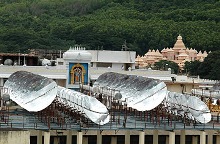India's Temples Go Green - a story about faith and carbon points
21 August 2008:
 |
 |
 |
The Tirumala Temple in India prepares 30,000 meals a day using solar technology. Photo from Time Magazine. |
This is the text of a news story in Time Magazine, India, reprinted on ARC's website with their kind permission.
By Madhur Singh: July 2007
The Tirumala temple, in the south Indian city of Tirupathi, is one of Hinduism's holiest shrines. Over 5,000 pilgrims a day visit this city of seven hills, filling Tirumala's coffers with donations and making it India's richest temple. But since 2002, Tirumala has also been generating revenue from a less likely source: carbon credits. For decades, the temple's community kitchen has fed nearly 15,000 people, cooking 30,000 meals a day. Five years ago, Tirumala adopted solar cooking technology, allowing it to dramatically cut down on the amount of diesel fuel it uses. The temple now sells the emission reduction credits it earns to a Swiss green-technology investor, Good Energies Inc.
Like Tirumala, dozens of holy places across India are moving quietly towards green energy. Muni Seva Ashram, in Gujarat, which combines spiritual practice with social activism, is working to make its premises entirely green by using solar, wind and biogas energy. A residential school for 400 students is already running exclusively on green energy. Starting this year, the ashram will also sell three million carbon credits. A similar movement is afoot at the revered Sai Baba Temple in Shirdi, Maharashtra. "Our aim is to avoid pollution in every way," says Raghunath Aher, the temple's chief engineer. "A holy place should be pure and completely in harmony with nature."
It's not surprising that religious groups are in the vanguard of India's green movement: India is the birthplace of four of the world's largest religions — Hinduism, Buddhism, Jainism and Sikhism, all of which revere nature and preach conservation. But the country's environmental practice hasn't always matched that preaching, leaving its air and water woefully polluted. According to the World Bank, emissions increased 57% in the decade following the India's economic liberalization.
Now, however, religious groups, keen to marry spirituality with sustainability, are leading the push to reverse that trend. Deepak Gadhia, founder of Gadhia Solar Energy Systems, which provided solar cooking technology to Tirumala temple, says more and more religious organizations have approached him in recent years. "With most businesses, the first question is of economics," he says, "But spiritual organizations look at larger issues. They want energy that is spiritually positive."
Art of Living, for instance, a 25-year-old spiritual organization that claims nearly 30 million followers in India, focuses on returning to "the way of life espoused in the ancient Hindu scriptures," according to spokesperson Mamta Kailkhura. The group is working with the government of Uttaranchal state to clean up the Ganges River and devise a waste disposal system for the holy city of Rishikesh. In the villages near Art of Living's ashram in Bangalore, a program to teach farmers organic methods and ancient water harvesting techniques is afoot. The ashram itself uses biogas for part of its lighting requirements, and recycles all of its water. Of course, it all makes sound economic sense: with the government subsidizing up to 50% of the costs of installing green technology, temples like Tirumala can make steady returns selling the resulting carbon credits.
And India's faith-based organizations are also helping spread the gospel of green. The UK-based Alliance of Religions and Conservation, which works with the UN to involve religious groups in environmental outreach, is working on a conservation campaign in the holy city of Vrindavan, as well as pushing India's 28,000 Sikh temples to convert their kitchens to green technology.
The combined potential of such efforts is limitless. India's religious groups have sizable incomes, own vast amounts of land, and have enormous influence on public opinion through their educational institutions. Indeed, with 99% of Indians professing to one faith or another, the country's green movement might not have a prayer without them.
Links
Link here for the full story in Time Magazine.
Other Hindu stories
A Balinese environmentalist who has worked with local Hindu leaders to protect tens of thousands of rare turtles every year, received a major international award for his work. Link here for more information.
2003: Surveys conducted by the World Bank in Indonesia revealed that religious leaders were among the most trusted members of society, and that these might be the leaders who can help people remember to care for their environment. Link here for more information.
|

